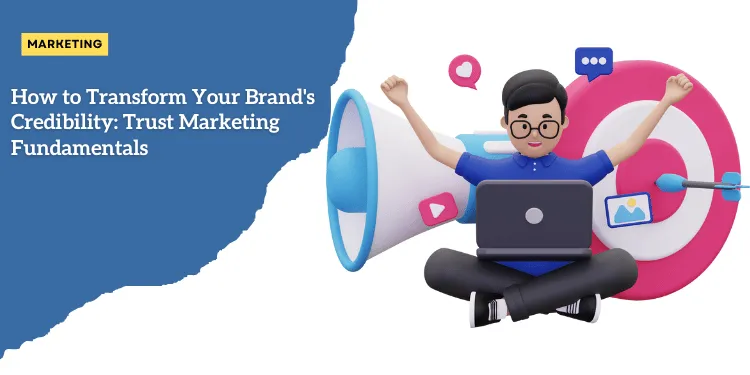How to Transform Your Brand’s Credibility: Trust Marketing Fundamentals

Anúncios
Defining Trust Marketing
Trust marketing is a pivotal strategy in modern business, encompassing both emotional and logical decision-making processes.
It’s about creating a sense of reliability and dependability around a brand.
Anúncios
Emotionally, consumers trust brands based on feelings of safety or alignment with their values.
Logically, trust is built through tangible evidence such as consistent positive experiences, honest communications, and verifiable credentials.
Calculating Trust: From Impressions to Experience
Consumers calculate trust by combining first impressions with past experiences.
Anúncios
Initial interactions with a brand—whether through a website visit or a customer service encounter—set the stage.
Positive first impressions can lead to a cautious optimism, which is either reinforced or diminished over time based on subsequent interactions.
| Aspect | Description |
|---|---|
| 🌟 First Impressions | These are immediate judgments based on initial contact points such as website design, ease of navigation, and professionalism in communication. |
| ⏳ Past Experiences | These encompass the cumulative history of interactions, ranging from product quality and service delivery to customer support and problem resolution. |
Consumers essentially perform a mental calculation, weighing these variables to decide how much they can rely on a brand.
The Impact of Trust on Purchase Decisions
Numerous studies underscore the critical role trust plays in purchase decisions.
For instance, a Trusted Shops survey revealed:
- 🔒 62% of respondents generally trust online shops.
- ⭐ 66% prioritize positive online reviews over price.
- 📖 79% read reviews every time or most of the time before making a purchase.
These statistics highlight the substantial influence consumer trust can have.
Brands that foster trust are more likely to see higher customer retention, positive word-of-mouth, and ultimately, increased sales.
This evidence firmly establishes trust marketing as essential for business success, necessitating strategies that consistently build and maintain consumer trust.
Building Trust Through Digital Presence
Transparent Contact Information
First and foremost, ensure your website features easily accessible contact information.
This creates an immediate sense of transparency and approachability.
Display vital details prominently, such as:
- 📧 An email address for customer inquiries
- 📞 A phone number for direct support
- 💬 A contact form or chatbot for real-time assistance
- 🔗 Links to social media profiles
Including these touchpoints can put visitors at ease, knowing they can reach out to you effortlessly.
Prominent Customer Reviews and Ratings
Customer reviews are integral for earning trust online. This social proof can be the tipping point for many consumers.
To maximize their impact:
- 🏠 Showcase overall store ratings on your homepage, possibly in the navigation bar or footer.
- 🌟 Highlight specific product reviews not just on product pages but also on the homepage and category pages.
- 🧩 Utilize widgets to display sample reviews across your site, including key points like the checkout page.
By emphasizing customer reviews, you’re demonstrating real-world validation of your products or services, which can significantly influence purchasing decisions.
Comprehensive Legal Pages and Policies
Consumers also look for solid legal standing and clear policies on company websites.
Create comprehensive legal pages, including:
- 📜 Terms and conditions
- 🔄 Return and refund policies
- 🔒 Privacy and cookie policies
- ℹ️ An About Us page
Ensure these pages are easy to find, either linked in your website footer or the main navigation menu.
Having detailed, accessible policies builds customer confidence by showing that your business operates transparently and ethically.
By structuring your website to include these trust-building elements, you foster an environment where potential customers feel secure and valued.
This sets the stage for more in-depth trust signals and strategic content marketing efforts.
Leveraging Google for Trust Signals
Understanding the Difference Between Product Reviews and Service Reviews
When it comes to building trust online, Google reviews play a pivotal role.
However, Google categorizes reviews into two distinct types: product reviews and service reviews.
-
📝 Product Reviews: These are ratings given by consumers specifically about a product (e.g., “The quality of this jacket is exceptional and worth every penny!”). They focus on the item itself and its performance, features, and quality.
-
🏬 Service Reviews: Also known as shop reviews, seller ratings, or store ratings, service reviews focus on the retailer’s performance (e.g., “Prompt delivery! Excellent customer service!”). They encompass aspects such as delivery speed, customer service quality, and the overall shopping experience.
Understanding this distinction is crucial because it helps businesses to address specific areas that foster trust, whether it is through the quality of the products they offer or the service they provide.
Optimizing Google OneBox, Shopping, and Ads with Trust Elements
Google offers several platforms where trust signals can be integrated to enhance visibility and trustworthiness:
Google OneBox
Google OneBox appears as a small box on the right side of some search engine results pages (SERPs), typically for brand searches. Ensuring that your Google OneBox showcases your ratings from trusted review providers like Trusted Shops can significantly boost consumer confidence.
Google Ads
For businesses running Google Ads, star ratings can be displayed if you collect customer reviews through supported Google review partners. This inclusion of ratings in ads not only catches the eye but also lends credibility. Using assets such as Google Ads Extensions can further enhance trust by providing additional verified information directly in the ad.
Google Shopping
Your Google Shopping posts, whether organic or paid, can also display star ratings. This visibility provides potential customers an immediate snapshot of your product’s reputation, potentially swaying their decision to purchase.
Integrating Review Systems with Google for Enhanced Visibility
To maximize the effectiveness of Google reviews, integrate review systems that are compatible with Google.
This ensures that your customer evaluations are consistently sent to Google, keeping your star ratings up to date and visible across different platforms.
Providers like Trusted Shops can synchronize your reviews, aiding in maintaining a harmonized and robust reputation across the internet.
Google prominently features these ratings, and well-displayed reviews act as strong trust signals, influencing purchasing decisions and fostering consumer confidence.
As we wrap up on leveraging Google for trust signals, remember that continuous engagement with review management systems can keep your ratings reflective of current service standards.
In the next section, we will delve into how effective content marketing can act as a trust builder, enriching your brand’s digital presence and further solidifying customer trust.
Content Marketing as a Trust Builder
Content marketing plays a fundamental role in building trust with your audience.
It requires creating valuable content that not only demonstrates your expertise and industry knowledge but also fosters authentic connections with your target market.
Create Valuable Content
Creating content that offers genuine value to your audience is essential.
Think about blog articles, eBooks, and “how-to” videos that provide solutions or insights into relevant topics within your industry.
When customers see that you are willing to share your knowledge freely, they begin to view your brand as a credible and authoritative source.
Social Media for Authentic Connections
Social media is a pivotal platform for fostering trust.
Use it to share behind-the-scenes content, showcasing the human side of your business. Share stories, process videos, and team member introductions to build a more personal relationship with your audience.
Regular and consistent social media activity also signals reliability and engagement to your followers.
Strategically Implement User-Generated Content
User-generated content (UGC) and testimonials are powerful tools for trust building.
Feature real customer reviews on your website and social media platforms.
When potential customers see positive feedback from their peers, it significantly boosts credibility.
Additionally, run campaigns encouraging customers to share their experiences with your brand using specific hashtags or participating in challenges.
By incorporating these strategies, you create a solid foundation of trust with your audience, which is essential for fostering long-term relationships and driving purchase decisions.
Advanced Trust Marketing Strategies
Building trust takes more than just a robust digital presence.
Advanced trust marketing strategies can significantly heighten your brand’s credibility and influence consumer behavior.
Let’s explore three key advanced tactics: partnering with influencers, integrating trust signals in traditional advertising, and utilizing trust badges and certifications.
Partnering with Influencers for Authentic Brand Endorsements
Influencer marketing has revolutionized how brands connect with their audiences.
Influencers hold considerable sway over their followers, making their endorsements invaluable.
When they genuinely appreciate and promote your product or service, their followers are more likely to trust your brand.
Industrial influencers can introduce your brand to a wider, yet targeted, audience.
You can sponsor their content, provide free samples, or collaborate on events.
This strategy not only boosts your reach but also bolsters trust through authentic endorsements. The key is to find influencers whose values align with your brand.
Incorporating Trust Signals in Traditional Advertising Channels
Traditional advertising is still a potent tool, especially when integrated with trust signals.
In print and television ads, showcasing your service ratings, certification logos, and any awards received can effectively convey trustworthiness.
Ensuring these elements are visible in your marketing materials strengthens consumer confidence and reinforces your credibility.
For instance, featuring your company’s long-standing history or industry ratings prominently in your ads can make a significant impact.
It reassures potential customers of your expertise and reliability, vital aspects of building trust.
Utilizing Trust Badges and Certifications Effectively
Trust badges and certifications are visual symbols of credibility.
They signify that your business meets certain standards and is recognized by reputable entities.
Displaying these symbols prominently on your website, email campaigns, and physical marketing materials can alleviate any doubts potential customers may have.
Examples include SSL certificates for website security, industry-standard badges for quality assurance, and third-party endorsements like the Better Business Bureau (BBB) accreditation.
These badges serve as quick visual cues that your brand is trustworthy and safe to engage with.
By leveraging these advanced strategies, you’re not only reinforcing trust but also ensuring it permeates every aspect of your brand’s visibility.
Measuring and Maintaining Trust
Track Customer Feedback and Review Metrics Consistently
To succeed in trust marketing, regularly track and analyze customer feedback and review metrics.
This consistent monitoring allows you to identify trends, understand customer sentiment, and uncover areas for improvement.
Consider implementing robust review management tools to aggregate feedback from multiple platforms. Use the following guidelines:
- 🔔 Set up automated alerts for new reviews or feedback.
- 📊 Categorize feedback by themes or issues to recognize recurring problems.
- 📋 Implement surveys or polls to gather detailed insights from customers.
By continually assessing these metrics, you will not only improve customer satisfaction but also enhance your brand’s credibility.
Monitor Brand Reputation Across Multiple Platforms
Your brand’s reputation is not limited to your website alone.
Consumers discuss, review, and rate brands across various platforms, including social media, forums, review websites, and third-party marketplaces.
Monitoring these discussions is crucial for maintaining trust.
- 🛠️ Use online reputation management tools to track mentions and reviews.
- ⏱️ Respond promptly and professionally to both positive and negative feedback.
- 📱 Engage with your audience on social media to show active listening and responsiveness.
Regular monitoring provides real-time insights into your brand perception and helps in quickly addressing any emerging issues.
Continuously Update and Improve Trust-Building Elements
Trust-building is an ongoing process that requires regular updates and modifications to keep up with changing consumer expectations and industry standards.
Here are some steps:
- 📜 Update Legal Pages and Policies: Ensure all legal pages on your site are up-to-date, clear, and comprehensive.
- 🔄 Refresh Content Regularly: Keep your website content, including blog posts, product descriptions, and customer stories, current and relevant.
- 🏅 Incorporate New Trust Signals: Introduce new trust signals like badges, certifications, or awards as they become relevant to your industry.
- 💼 Invest in Customer Service: Regular training for your customer service team ensures they provide excellent support, reinforcing trust.
By adopting these strategies diligently, you continue to build and maintain the trust that is vital to your brand’s success.
Maintaining strong trust metrics not only reinforces your brand’s credibility but also fosters lasting customer loyalty, necessary for long-term business growth.






